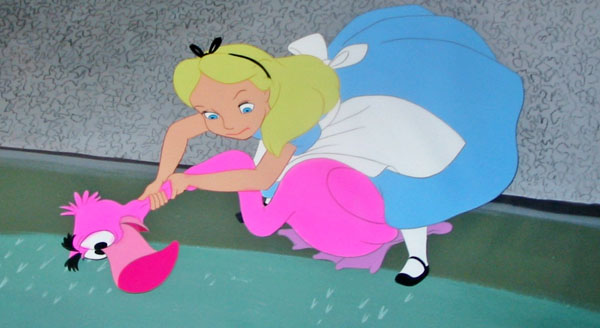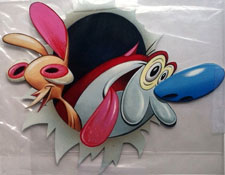
Technicolor Peculiarities. Many animation fans don’t quite understand Technicolor, other than the fact that it provided a spectacular color effect. However, the system could be unpredictable which is why Disney made many color tests to compensate for those peculiarities. For instance, in Disney’s Alice in Wonderland (1951), if you look closely at the cels featuring Alice’s yellow hair, there is a slight green tint.
When it was filmed, that green would disappear but without it her golden hair would look at little whiter. So, when Disney claims that when it restores the color in newer released versions of the classic film, it examines the original existing cels, we can only hope that the color that Walt and his artists really wanted is the one that is chosen.
 What are Ren and Stimpy? Voice artist Billy West told the LA Weekly newspaper in December 2005 about the first time he saw the early sketches for Ren and Stimpy: “I’m looking at them and wondering: What are they? Are they microbes? Is one a mosquito? I got it suddenly…it doesn’t matter what they look like. This is beautiful. One is the quintessential asshole. He’s a combination of five different assholes and Stimpy was like a man-boy, only he was a cat.
What are Ren and Stimpy? Voice artist Billy West told the LA Weekly newspaper in December 2005 about the first time he saw the early sketches for Ren and Stimpy: “I’m looking at them and wondering: What are they? Are they microbes? Is one a mosquito? I got it suddenly…it doesn’t matter what they look like. This is beautiful. One is the quintessential asshole. He’s a combination of five different assholes and Stimpy was like a man-boy, only he was a cat.
“I used the Larry Fine voice from The Three Stooges for Stimpy and pitched it way up to adhere to a cartoon unisphere rather than the earthly one we live in. Ren was a cross between Peter Lorre, Burl Ives and Kirk Douglas.”
No Noah Film. In 2006, Casey Affleck, the younger brother of actor Ben Affleck, had sold to Warner Brothers a screenplay entitled “Aardvark Art’s Ark” that he would executive produce. The animated feature was about an animal family stranded when they are not chosen to go on Noah’s Ark. Adam Sachs was brought in to rewrite the script.
In 2014, Unified Pictures announced it was doing an animated feature directed by John (Kung Fu Panda) Stevenson and written by Phillip (Prince of Egypt, Pocahontas, Mulan) LaZebnik with an aardvark named Gilbert “who becomes the reluctant leader of a ragtag group of misfit animals that need to be led to the mighty ark before the impending flood. Along their journey, they band together to conquer unforeseen obstacles, and ultimately, Gilbert discovers within himself the inner strength and ingenuity to prove that in a world of ‘twos,’ he was truly destined to be ‘the one.’ ”
Other animated features based on Noah’s Ark are in different stages of production including “Noah’s Ark: The New Beginning” (Promenade Pictures), “Rock the Boat” (Gaumont) about “a porcupine and cheetah who, since their species are already represented on Noah’s Ark, disguise themselves as a fictitious hybrid — porceetahs — to gain passage,” and “Not the End of the World” (Illuminated Films) based on the Geraldine McCaughrean novel and told from the point of view of Noah’s youngest daughter.
Circle 7’s Toy Story 3. Pixar executives do not talk about Circle 7, an animation division started by Disney CEO Michael Eisner to produce new films based on the Pixar characters. It was located on Circle 7 Drive (hence the inspiration for the name) in Glendale, California and was started in 2004 with a staff of 170 people. Many believe that Eisner only created the studio as a lever to get more favorable terms on a new contract with Pixar.
 The first project was to be Toy Story 3 directed by Bradley (Lion King 1 ½) Raymond and written by Jim (Meet the Parents, Meet the Fockers) Herzfeld. At least one writer before Herzfeld and two afterwards also worked on the script.
The first project was to be Toy Story 3 directed by Bradley (Lion King 1 ½) Raymond and written by Jim (Meet the Parents, Meet the Fockers) Herzfeld. At least one writer before Herzfeld and two afterwards also worked on the script.
“I should have had my agent look into it more. We were just pawns, used to scare Pixar to the negotiation table. It was essentially Michael Eisner putting a gun to the head of Pixar’s children,” said Herzfeld in 2006 to Entertainment Weekly magazine. “I can understand that. Somebody took (Pixar’s) children and dressed them up in clothes they didn’t approve of. But it doesn’t mean they’re bad clothes.”
When Eisner left in 2005, Iger reconciled with Pixar just three months later and John Lasseter and Ed Catmull were put in charge of Disney animation. The first thing they did was pull the plug on Circle 7.
Here is the synopsis of Circle 7’s plan for Toy Story 3:
Buzz starts to malfunction (eg. random speech bursts, hand pops off, scratches Andy with his pointy arm stump). The other toys arrange to have him shipped to Taipei where they believe he will be fixed at the original factory. Hamm the pig discovers that the Buzz Lightyears are part of a massive recall to be destroyed. So the toys ship themselves to Taipei to try to save their friend. Buzz encounters some other toys including Cozy Rosey (a tuck-in doll whose heating element catches fire), Jujubee Bee (a Pez imitation) and a tall female action figure named Jade with defective legs.
Chuck Jones on Mr. Magoo. “In animation, it became unfashionable and a little shameful to animate in the great tradition and animators found little pride in their craft and no innovations of animation worthy of note are to be found in the so-called UPA school.
“It is an odd kind of indictment of the failure of this great opportunity that the only surviving UPA character still in public demand is Mr. Magoo and Mr. Magoo was the only UPA character in the 1930 tradition: shave Grumpy of the Seven Dwarfs and you have Mr. Magoo.
“Mr. Magoo was also a truly animated character because you understood what he was by what he did, not by what he said he did, or by what someone else—usually a narrator—said he did. Most UPA pictures had a narrator of one kind or another.”
Chuck Jones shared this insight in his mid-1960s essay “The Tablet and the Dinosaur” (the dinosaur reference was to all the old animators like himself who did full animation) done for the Canyon Crier newspaper published in North Hollywood, California. In the late 1950s and into the 1980s Chuck Jones kept a home in the Hollywood Hills on Tareco Drive. Over the years, he contributed drawings to the local paper “Canyon Crier” and occasional writings as well as designing the image for the masthead.



 Jim Korkis is an internationally respected animation historian who in recent years has devoted his attention to the many worlds of Disney. He was a columnist for a variety of animation magazines. With his former writing partner, John Cawley, he authored several animation related books including The Encyclopedia of Cartoon Superstars, How to Create Animation, Cartoon Confidential and Get Animated’s Animation Art Buyer’s Guide. He taught animation classes at the Disney Institute in Florida as well as instructing classes on acting and animation history for Disney Feature Animation: Florida.
Jim Korkis is an internationally respected animation historian who in recent years has devoted his attention to the many worlds of Disney. He was a columnist for a variety of animation magazines. With his former writing partner, John Cawley, he authored several animation related books including The Encyclopedia of Cartoon Superstars, How to Create Animation, Cartoon Confidential and Get Animated’s Animation Art Buyer’s Guide. He taught animation classes at the Disney Institute in Florida as well as instructing classes on acting and animation history for Disney Feature Animation: Florida.




















































Two other recent Noah’s Ark animated features are (1) the 2007 Argentine “El Arca”, released in the U.S. last year (after a very limited theatrical release) as a Direct-to-DVD by The Shout! Factory, packaged to look like one of those children’s DVDs of animated Bible stories. Since it was an adult risqué comedy in Argentina (the animals set up a night club on the Ark; a horny porcupine or hedgehog rapes a pineapple), there were outraged complaints by parents or grandparents who bought it for the kiddies. (2) The 2015 German “Ooops! Noah’s Gone …” (“Ooops! Die Arche ist Weg …) will come out this year; in July in Germany and later in the U.S., possibly retitled “Two by Two”.
https://www.youtube.com/watch?v=3Pu_Bpms8Cg
https://www.youtube.com/watch?v=spcghvLHXdk
Hey Jim, have you got any anecdotes about this – Brad Bird’s pencil test for “The Spirit”?http://blogs.indiewire.com/animationscoop/brad-birds-lost-1980-pencil-test-for-the-spirit-20150414
If so, now would be the perfect timing. 😉
Of course they’re all ripoffs of “Yogi’s Ark Lark.” If an HB lawyer reads this, I want a cut of the settlements.
I remember that the proposed non-Pixar Toy Story 3 also would have been made without Tom Hanks and Tim Allen.
Actually Tim Allen signed on to that version of Toy Story 3 stating he would always reprise the role of Buzz Lightyear
One of the problems of Technicolor was that it could not reproduce white! Because the printing process was more like lithography than anything else, there had to be some color in every part of the image for it to work properly. So Technicolor “white” was actually a light gray, so that the dyes on the Y-C-M “stampers” would make full contact with the print stock.
Technicolor print stock (they called it “blank;”) had only a silver-based black and white sound track which was exposed, printed and developed in the same way as regular b/w film. Then the color matrices were synchronized and pressed against the processed soundtrack print. This applied to live-action films as well, “Technicolor white” shirts were also actually gray.
It was located on Circle 7 Drive (hence the inspiration for the name)
“Circle 7” itself I’m sure is derived from the logo used by ABC owned and operated stations that broadcast on channel 7 throughout the country.
http://en.wikipedia.org/wiki/Circle_7_logo
There are other factors to consider when using cels as reference for film restoration. Cels tend to darken the color underneath, so colors were sometimes altered accordingly. There are also optical effects to consider, like filters or multiple exposures. And with older cels there’s the possibility of discoloration.